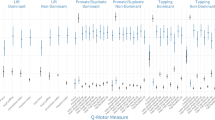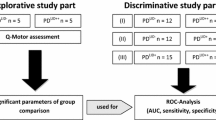Abstract
Identifying frontal impairment in ALS is an important goal albeit disease-dedicated tools are still scarce. For this reason, we decided to consider primitive reflexes (PRs), variably regarded as correlates of frontal release and/or of upper motor neuron (UMN) impairment, often in the setting of dementias. Specifically, the aims of this work consisted in assessing the exact prevalence of the combination of seven PRs in ALS, trying to clarify their role as putative proxies of cognitive impairment or of UMN dysfunction. In this cross-sectional study, 50 consecutive ALS outpatients were evaluated for the presence of: palmomental (PM), corneomandibular (CM), glabella tap (MY), rooting, sucking, snout, and grasping reflexes. Cognitive screening was performed by the Frontal Assessment Battery (FAB) and the Weigl’s Sorting test (WST); UMN dysfunction was concomitantly evaluated. PM, CM and MY were more frequently detected (62, 52, and 44 % of the ALS sample, respectively), while the other reflexes were under-represented. Patients displaying three or more PRs had significantly lower FAB and WST scores. On the other hand, UMN dysfunction was only moderately associated to PRs. In conclusion, PRs’ assessment is a promising complementary tool for screening cognitive impairment in ALS; however, further work will be necessary to establish its added value with respect to already existing ALS-dedicated screening tools for cognition.


Similar content being viewed by others
References
Robberecht W, Philips T (2013) The changing scene of amyotrophic lateral sclerosis. Nat Rev Neurosci 14:248–264
Ling SC, Polymenidou M, Cleveland DW (2013) Converging mechanisms in ALS and FTD: disrupted RNA and protein homeostasis. Neuron 79:416–438
Chiò A, Ilardi A, Cammarosano S, Moglia C, Montuschi A, Calvo A (2012) Neurobehavioral dysfunction in ALS has a negative effect on outcome and use of PEG and NIV. Neurology 78:1085–1089
Elamin M, Bede P, Byrne S, Jordan N, Gallagher L, Wynne B, O’Brien C, Phukan J, Lynch C, Pender N, Hardiman O (2013) Cognitive changes predict functional decline in ALS: a population-based longitudinal study. Neurology 80:1590–1597
Tremolizzo L, Ferrarese C, Appollonio I (2013) Exploring limits of neuropsychological screening in ALS: the FAB problem. Amyotroph Lateral Scler Frontotemporal Degener 14:157–158
Woolley SC, York MK, Moore DH, Strutt AM, Murphy J, Schulz PE, Katz JS (2010) Detecting frontotemporal dysfunction in ALS: utility of the ALS cognitive behavioral screen (ALS-CBS). Amyotroph Lateral Scler 11:303–311
Abrahams S, Newton J, Niven E, Foley J, Bak TH (2014) Screening for cognition and behaviour changes in ALS. Amyotroph Lateral Scler Frontotemporal Degener 15:9–14
Miller RG, Jackson CE, Kasarskis EJ, England JD, Forshew D, Johnston W, Kalra S, Katz JS, Mitsumoto H, Rosenfeld J, Shoesmith C, Strong MJ, Woolley SC, Quality Standards Subcommittee of the American Academy of Neurology (2009) Practice parameter update: the care of the patient with amyotrophic lateral sclerosis: multidisciplinary care, symptom management, and cognitive/behavioral impairment (an evidence-based review): report of the quality standards subcommittee of the American academy of neurology. Neurology 73:1227–1233
Schott JM, Rossor MN (2003) The grasp and other primitive reflexes. J Neurol Neurosurg Psychiatry 74:558–560
Strong MJ (2012) Amyotrophic lateral sclerosis and the frontotemporal dementias. Oxford University Press, Oxford
Brazis PW, Masdeu JC, Biller J (eds) (2012) Localization in clinical neurology. Lippincott Williams & Wilkins, London
Girling DM, Berrios GE (1990) Extrapyramidal signs, primitive reflexes and frontal lobe function in senile dementia of the Alzheimer type. Br J Psychiatry 157:888–893
Heliopoulos I, Vadikolias K, Tsivgoulis G, Mikroulis D, Tsakaldimi S, Piperidou C (2013) Corneomandibular reflex (Wartenberg reflex) in coma: a rarely elicited sign. JAMA Neurol 70:794–795
Nicolson SE, Chabon B, Larsen KA, Kelly SE, Potter AW, Stern TA (2011) Primitive reflexes associated with delirium: a prospective trial. Psychosomatics 52:507–512
Di Legge S, Di Piero V, Altieri M, Vicenzini E, Tombari D, Di Stani F, Lenzi GL (2001) Usefulness of primitive reflexes in demented and non-demented cerebrovascular patients in daily clinical practice. Eur Neurol 45:104–110
Loeb C, Gandolfo C, Caponnetto C, Del Sette M (1990) Pseudobulbar palsy: a clinical computed tomography study. Eur Neurol 30:42–46
Brooks BR, Miller RG, Swash M, Munsat TL, World Federation of Neurology Research Group on Motor Neuron Diseases (2000) El Escorial revisited: revised criteria for the diagnosis of amyotrophic lateral sclerosis. Amyotroph Lateral Scler Other Motor Neuron Disord 1:293–299
Appollonio I, Leone M, Isella V, Piamarta F, Consoli T, Villa ML, Forapani E, Russo A, Nichelli P (2005) The frontal assessment battery (FAB): normative values in an Italian population sample. Neurol Sci 26:108–116
Laiacona M, Inzaghi MG, De Tanti A, Capitani E (2000) Wisconsin card sorting test: a new global score, with Italian norms, and its relationship with the Weigl sorting test. Neurol Sci 21:279–291
Owen G, Mulley GP (2002) The palmomental reflex: a useful clinical sign? J Neurol Neurosurg Psychiatry 73:113–115
Marinesco G, Radovici A (1920) Sur un reflexe cutane nouveau: reflexe palmo-mentonnier. Rev Neurol 27:237–240
Okuda B, Kodama N, Kawabata K, Tachibana H, Sugita M (1999) Corneomandibular reflex in ALS. Neurology 52:1699–1701
Pearce J, Aziz H, Gallagher JC (1968) Primitive reflex activity in primary and symptomatic Parkinsonism. J Neurol Neurosurg Psychiatry 31:501–508
Jenkyn LR, Walsh DB, Culver CM, Reeves AG (1977) Clinical signs in diffuse cerebral dysfunction. J Neurol Neurosurg Psychiatry 40:956–966
Aliberti S, Messinesi G, Gramegna A, Tremolizzo L, Susani E, Pesci A (2013) Diaphragm ultrasonography in the management of patients with amyotrophic lateral sclerosis. Amyotroph Lateral Scler Frontotemporal Degener 14:154–156
Smith RA, Berg JE, Pope LE, Thisted RA (2004) Measuring pseudobulbar affect in ALS. Amyotroph Lateral Scler Other Motor Neuron Disord 5(Suppl 1):99–102
Miller TM, Johnston SC (2005) Should the Babinski sign be part of the routine neurologic examination? Neurology 65:1165–1168
Marti-Vilalta JL, Graus F (1984) The palmomental reflex. Clinical study of 300 cases. Eur Neurol 23:12–16
Isakov E, Sazbon L, Costeff H, Luz Y, Najenson T (1984) The diagnostic value of three common primitive reflexes. Eur Neurol 23:17–21
Borroni B, Broli M, Costanzi C, Gipponi S, Gilberti N, Agosti C, Padovani A (2006) Primitive reflex evaluation in the clinical assessment of extrapyramidal syndromes. Eur J Neurol 13:1026–1028
Links KA, Merims D, Binns MA, Freedman M, Chow TW (2010) Prevalence of primitive reflexes and Parkinsonian signs in dementia. Can J Neurol Sci 37:601–607
Sjögren M, Wallin A, Edman A (1997) Symptomatological characteristics distinguish between frontotemporal dementia and vascular dementia with a dominant frontal lobe syndrome. Int J Geriatr Psychiatry 12:656–661
Acknowledgments
Mrs. Sofia Rosso and the Italian association for ALS (AISLA).
Conflicts of interest
The authors declare that they have no conflict of interest.
Author information
Authors and Affiliations
Corresponding author
Rights and permissions
About this article
Cite this article
Tremolizzo, L., Susani, E., Lunetta, C. et al. Primitive reflexes in amyotrophic lateral sclerosis: prevalence and correlates. J Neurol 261, 1196–1202 (2014). https://doi.org/10.1007/s00415-014-7342-7
Received:
Revised:
Accepted:
Published:
Issue Date:
DOI: https://doi.org/10.1007/s00415-014-7342-7




